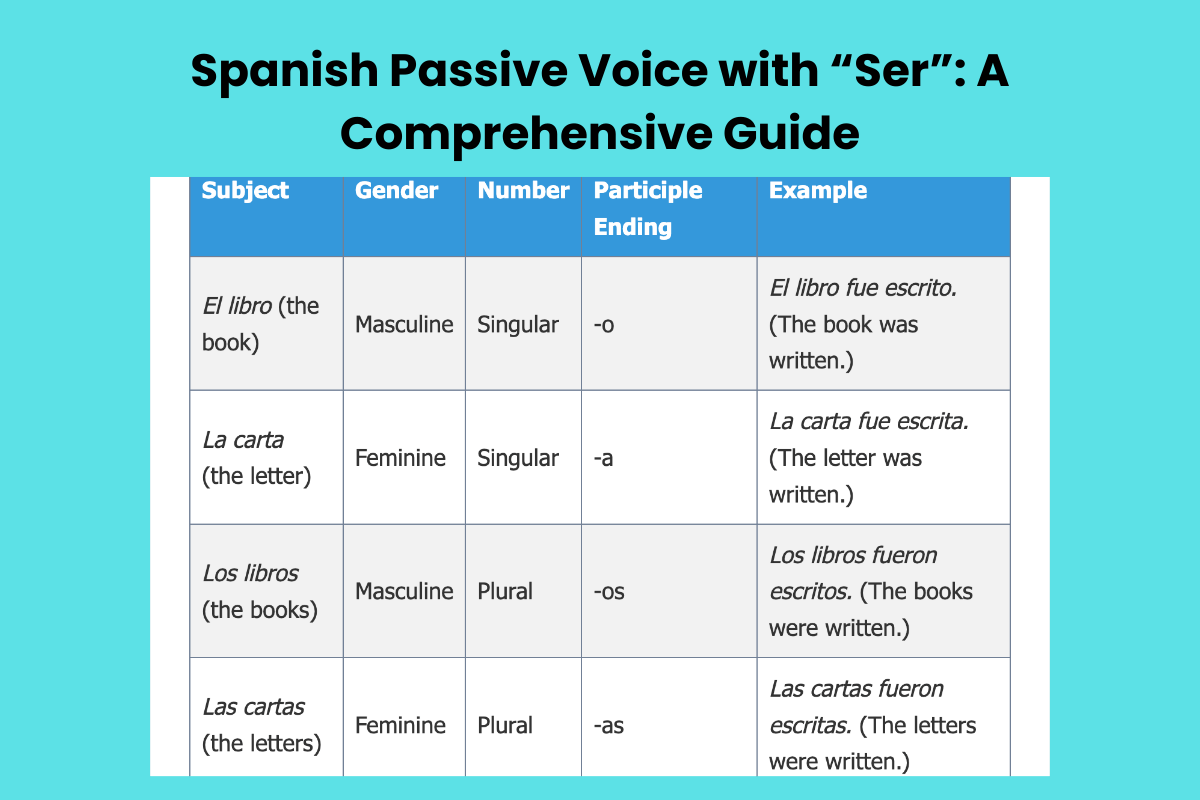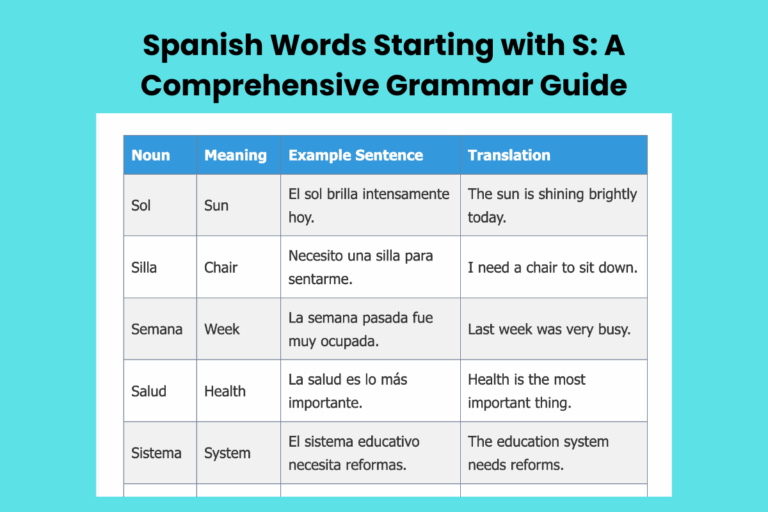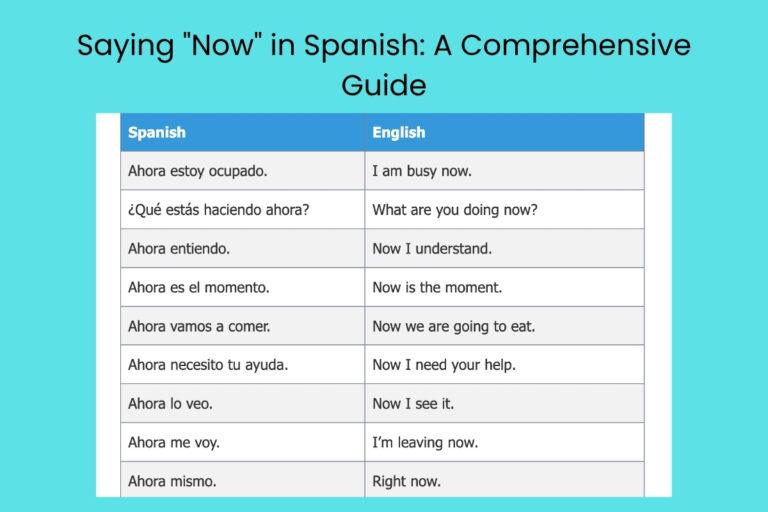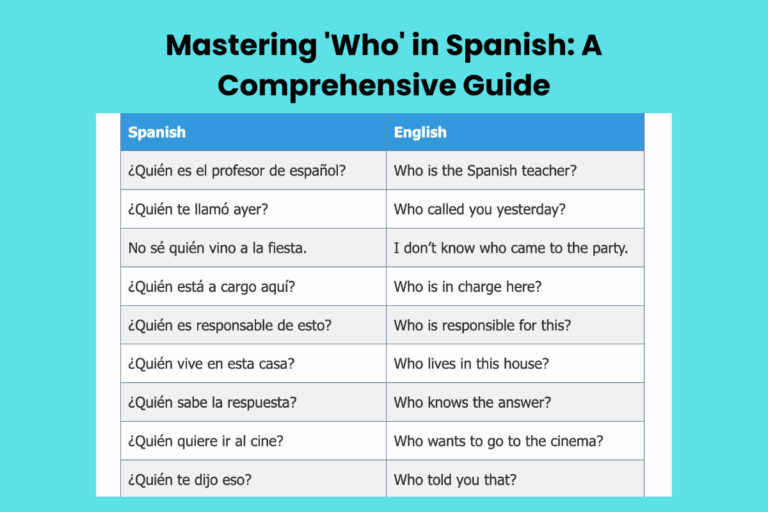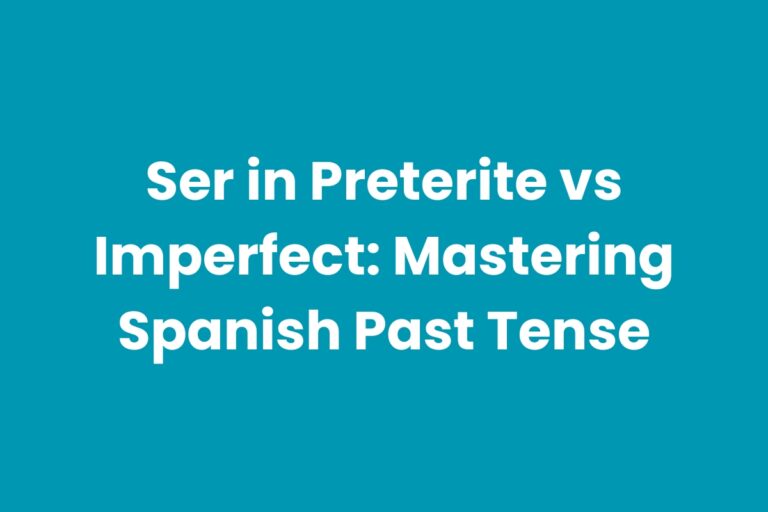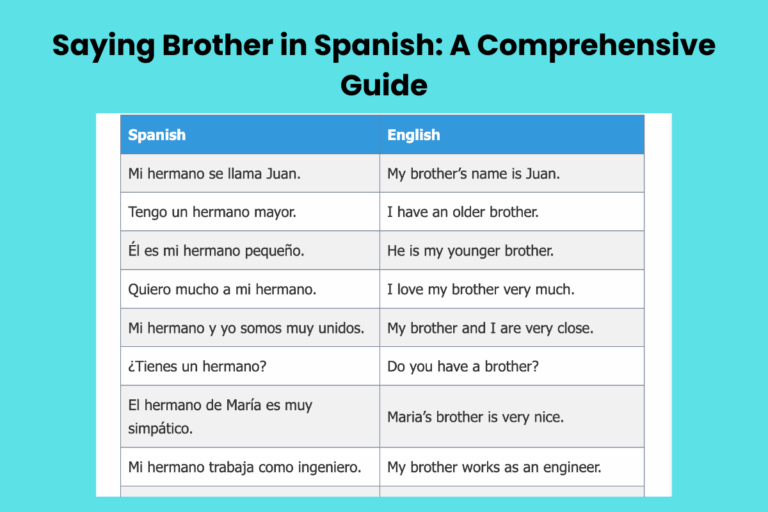Spanish Passive Voice with “Ser”: A Comprehensive Guide
Mastering the passive voice with ser is crucial for advanced Spanish learners. It enables you to shift the focus of a sentence from the actor to the receiver of the action, providing a more nuanced and sophisticated way to express ideas. This guide provides a detailed exploration of the passive voice, its structure, usage rules, and common pitfalls, empowering you to use it accurately and confidently. This article is designed for intermediate to advanced Spanish learners aiming to refine their grammatical skills and achieve fluency.
Table of Contents
- Introduction
- Definition of the Passive Voice with “Ser”
- Structural Breakdown
- Agreement in Passive Voice
- Uses of the Passive Voice with “Ser”
- Examples
- Usage Rules
- Common Mistakes
- Practice Exercises
- Advanced Topics
- FAQ
- Conclusion
Definition of the Passive Voice with “Ser”
The passive voice in Spanish, formed with the verb ser (to be), is used to emphasize the action or the receiver of the action rather than the performer of the action. It is a grammatical construction where the subject of the sentence is acted upon by the verb. In essence, the subject receives the action instead of performing it. The passive voice is particularly useful when the actor is unknown, unimportant, or obvious from the context.
Unlike the active voice, where the subject performs the action (e.g., “The chef cooked the meal”), the passive voice focuses on the object being acted upon (e.g., “The meal was cooked by the chef”). This shift in focus can change the tone and emphasis of a sentence, making it more appropriate for certain contexts.
The passive voice with ser is a formal construction and is less frequently used in spoken Spanish compared to other passive constructions, such as using the impersonal “se.” However, it’s crucial to understand it for reading comprehension, formal writing, and achieving a deeper understanding of Spanish grammar.
Structural Breakdown
The structure of the passive voice with ser is as follows:
Subject (receiver of the action) + ser (conjugated) + past participle + por + agent (optional)
Let’s break down each component:
- Subject: The noun or pronoun that receives the action of the verb.
- Ser: The verb “to be” conjugated in the appropriate tense (present, preterite, imperfect, future, conditional, etc.). The tense of ser determines the time frame of the action.
- Past Participle: The past participle of the main verb. It must agree in gender and number with the subject. For example, if the subject is feminine singular, the past participle must also be feminine singular.
- Por: This preposition introduces the agent (the person or thing performing the action). It’s equivalent to “by” in English.
- Agent: The noun or pronoun that performs the action. The agent is often omitted if it is unknown, unimportant, or obvious.
Consider the example: “La carta fue escrita por María.” (The letter was written by Maria.)
- Subject: La carta (the letter)
- Ser: fue (was – past tense of ser)
- Past Participle: escrita (written – feminine singular, agreeing with la carta)
- Por: by
- Agent: María (Maria)
Agreement in Passive Voice
A critical aspect of using the passive voice with ser correctly is ensuring agreement between the subject and the past participle. The past participle must agree in both gender and number with the subject of the sentence.
Here’s a table illustrating the agreement rules:
| Subject | Gender | Number | Past Participle Ending | Example |
|---|---|---|---|---|
| El libro (the book) | Masculine | Singular | -o | El libro fue escrito. (The book was written.) |
| La carta (the letter) | Feminine | Singular | -a | La carta fue escrita. (The letter was written.) |
| Los libros (the books) | Masculine | Plural | -os | Los libros fueron escritos. (The books were written.) |
| Las cartas (the letters) | Feminine | Plural | -as | Las cartas fueron escritas. (The letters were written.) |
Pay close attention to this agreement, as incorrect agreement is a common mistake among Spanish learners.
Uses of the Passive Voice with “Ser”
The passive voice with ser is used in specific situations to achieve particular effects.
- Emphasis on the Action: When the action itself is more important than the actor. Example: La ley fue aprobada ayer. (The law was approved yesterday.) The focus is on the approval of the law, not who approved it.
- Unknown Actor: When the actor is unknown or not specified. Example: El banco fue robado. (The bank was robbed.) We don’t know who robbed the bank.
- Unimportant Actor: When the actor is not relevant to the message. Example: La casa fue construida en 1920. (The house was built in 1920.) The builder is not important information.
- Formal Contexts: The passive voice is more common in formal writing and official reports. Example: Los resultados serán anunciados mañana. (The results will be announced tomorrow.)
- Objectivity: To present information in an objective and impersonal way. Example: Se ha demostrado que… (It has been demonstrated that…). This is often used in scientific and academic writing; although, this example uses “se” as previously mentioned.
Examples
Here are several examples of the passive voice with ser in different tenses:
Present Tense Examples
In the present tense, ser is conjugated as soy, eres, es, somos, sois, son.
| Spanish | English |
|---|---|
| El libro es leído por los estudiantes. | The book is read by the students. |
| La tarea es corregida por el profesor. | The homework is corrected by the professor. |
| Las flores son regadas por mi madre. | The flowers are watered by my mother. |
| Los coches son lavados en el garaje. | The cars are washed in the garage. |
| La cena es preparada por mi hermana. | The dinner is prepared by my sister. |
| El pastel es horneado por la abuela. | The cake is baked by the grandmother. |
| Los platos son lavados por Juan. | The dishes are washed by Juan. |
| Las ventanas son limpiadas por el conserje. | The windows are cleaned by the janitor. |
| La ropa es planchada por mi padre. | The clothes are ironed by my father. |
| Los correos electrónicos son enviados por la secretaria. | The emails are sent by the secretary. |
| El informe es revisado por el gerente. | The report is reviewed by the manager. |
| La canción es cantada por el artista. | The song is sung by the artist. |
| Los documentos son firmados por el director. | The documents are signed by the director. |
| La puerta es cerrada por el guardia. | The door is closed by the guard. |
| Los regalos son comprados por mi esposo. | The gifts are bought by my husband. |
| La mesa es puesta por mi hijo. | The table is set by my son. |
| Los libros son organizados por la bibliotecaria. | The books are organized by the librarian. |
| La carta es escrita a mano. | The letter is written by hand. |
| Los boletos son vendidos en la taquilla. | The tickets are sold at the box office. |
| La pizza es comida por todos. | The pizza is eaten by everyone. |
| El coche es conducido por el chófer. | The car is driven by the driver. |
| Las noticias son informadas por el periodista. | The news is reported by the journalist. |
| El café es servido por el camarero. | The coffee is served by the waiter. |
| Las preguntas son respondidas por el experto. | The questions are answered by the expert. |
| El problema es resuelto por el ingeniero. | The problem is solved by the engineer. |
Preterite Tense Examples
In the preterite tense, ser is conjugated as fui, fuiste, fue, fuimos, fuisteis, fueron.
| Spanish | English |
|---|---|
| La casa fue construida en 1950. | The house was built in 1950. |
| El libro fue escrito por Gabriel García Márquez. | The book was written by Gabriel García Márquez. |
| Las puertas fueron cerradas con llave. | The doors were locked. |
| Los prisioneros fueron liberados ayer. | The prisoners were released yesterday. |
| La película fue dirigida por Spielberg. | The movie was directed by Spielberg. |
| El concierto fue organizado por la escuela. | The concert was organized by the school. |
| Las flores fueron plantadas en el jardín. | The flowers were planted in the garden. |
| El coche fue reparado por el mecánico. | The car was repaired by the mechanic. |
| La carta fue enviada por correo certificado. | The letter was sent by certified mail. |
| Los resultados fueron anunciados anoche. | The results were announced last night. |
| La comida fue preparada por mi abuela. | The food was prepared by my grandmother. |
| El cuadro fue pintado por Picasso. | The painting was painted by Picasso. |
| Las canciones fueron cantadas por el coro. | The songs were sung by the choir. |
| El problema fue resuelto rápidamente. | The problem was solved quickly. |
| La decisión fue tomada por el consejo. | The decision was made by the council. |
| El accidente fue causado por la lluvia. | The accident was caused by the rain. |
| Las luces fueron apagadas antes de dormir. | The lights were turned off before sleeping. |
| El premio fue ganado por el atleta. | The prize was won by the athlete. |
| La verdad fue descubierta después de años. | The truth was discovered after years. |
| El misterio fue revelado al final. | The mystery was revealed at the end. |
| El secreto fue guardado por muchos años. | The secret was kept for many years. |
| La información fue filtrada a la prensa. | The information was leaked to the press. |
| El acuerdo fue firmado por ambos países. | The agreement was signed by both countries. |
| El fuego fue extinguido por los bomberos. | The fire was extinguished by the firefighters. |
Imperfect Tense Examples
In the imperfect tense, ser is conjugated as era, eras, era, éramos, erais, eran.
| Spanish | English |
|---|---|
| La cena era preparada por mi madre cada noche. | Dinner was prepared by my mother every night. |
| Los deberes eran hechos por los niños después de la escuela. | The homework was done by the children after school. |
| El café era servido por el camarero cada mañana. | Coffee was served by the waiter every morning. |
| La casa era limpiada por la asistenta cada semana. | The house was cleaned by the maid every week. |
| Las cartas eran escritas a mano en esa época. | The letters were written by hand in that era. |
| Los coches eran conducidos por los padres. | The cars were driven by the parents. |
| La música era tocada por la orquesta en el teatro. | The music was played by the orchestra in the theater. |
| Los cuentos eran leídos por la abuela antes de dormir. | The stories were read by the grandmother before sleeping. |
| La ropa era lavada en el río. | The clothes were washed in the river. |
| Los animales eran alimentados por el granjero. | The animals were fed by the farmer. |
| El pan era horneado por el panadero cada día. | The bread was baked by the baker every day. |
| Las clases eran impartidas por profesores expertos. | The classes were taught by expert teachers. |
| Los problemas eran resueltos por el equipo de ingenieros. | The problems were solved by the team of engineers. |
| La comida era cocinada en la estufa de leña. | The food was cooked on the wood stove. |
| Las ventanas eran abiertas por la mañana. | The windows were opened in the morning. |
| Los ejercicios eran corregidos por el profesor. | The exercises were corrected by the teacher. |
| La historia era contada por los ancianos. | The story was told by the elders. |
| Los secretos eran guardados por los amigos. | The secrets were kept by the friends. |
| La verdad era buscada por los investigadores. | The truth was sought by the investigators. |
| Los sueños eran soñados por los niños. | The dreams were dreamed by the children. |
| La nieve era pisada por los transeúntes. | The snow was trampled by the passersby. |
| Los campos eran labrados por los agricultores. | The fields were plowed by the farmers. |
| La iglesia era visitada por los feligreses. | The church was visited by the parishioners. |
Future Tense Examples
In the future tense, ser is conjugated as seré, serás, será, seremos, seréis, serán.
| Spanish | English |
|---|---|
| La tarea será terminada mañana. | The homework will be finished tomorrow. |
| El proyecto será presentado la semana que viene. | The project will be presented next week. |
| La casa será vendida el mes próximo. | The house will be sold next month. |
| Los resultados serán anunciados pronto. | The results will be announced soon. |
| La ley será aprobada por el congreso. | The law will be approved by the congress. |
| El concierto será organizado por la comunidad. | The concert will be organized by the community. |
| Los libros serán donados a la biblioteca. | The books will be donated to the library. |
| La película será vista por millones de personas. | The movie will be seen by millions of people. |
| El premio será otorgado al ganador. | The prize will be awarded to the winner. |
| La verdad será revelada algún día. | The truth will be revealed someday. |
| El misterio será resuelto por los detectives. | The mystery will be solved by the detectives. |
| La comida será servida a las ocho. | The food will be served at eight o’clock. |
| Los boletos serán vendidos en línea. | The tickets will be sold online. |
| La fiesta será celebrada en la playa. | The party will be celebrated on the beach. |
| Los planes serán confirmados pronto. | The plans will be confirmed soon. |
| El problema será abordado por el equipo. | The problem will be addressed by the team. |
| La decisión será tomada por la junta directiva. | The decision will be made by the board of directors. |
| La información será compartida con todos. | The information will be shared with everyone. |
| Los cambios serán implementados gradualmente. | The changes will be implemented gradually. |
| El acuerdo será firmado por ambas partes. | The agreement will be signed by both parties. |
| El edificio será inaugurado el próximo año. | The building will be inaugurated next year. |
| La exposición será visitada por muchos turistas. | The exhibition will be visited by many tourists. |
Conditional Tense Examples
In the conditional tense, ser is conjugated as sería, serías, sería, seríamos, seríais, serían.
| Spanish | English |
|---|---|
| La casa sería vendida si el precio fuera justo. | The house would be sold if the price were fair. |
| El libro sería publicado si encontráramos un editor. | The book would be published if we found a publisher. |
| La película sería vista por más gente si fuera promocionada mejor. | The movie would be seen by more people if it were promoted better. |
| El problema sería resuelto si tuviéramos más recursos. | The problem would be solved if we had more resources. |
| La carta sería enviada si tuviéramos la dirección. | The letter would be sent if we had the address. |
| Los resultados serían mejores si trabajáramos más duro. | The results would be better if we worked harder. |
| La fiesta sería celebrada en el jardín si no lloviera. | The party would be celebrated in the garden if it didn’t rain. |
| El premio sería otorgado a la persona más meritoria. | The prize would be awarded to the most deserving person. |
| La verdad sería revelada si alguien hablara. | The truth would be revealed if someone spoke. |
| El misterio sería aclarado si tuviéramos más pistas. | The mystery would be clarified if we had more clues. |
| La comida sería preparada por el chef si tuviéramos los ingredientes. | The food would be prepared by the chef if we had the ingredients. |
| Los boletos serían comprados si tuviéramos dinero. | The tickets would be bought if we had money. |
| La decisión sería tomada si tuviéramos toda la información. | The decision would be made if we had all the information. |
| La información sería compartida si fuera confidencial. | The information would be shared if it were confidential. |
| Los cambios serían implementados si fueran necesarios. | The changes would be implemented if they were necessary. |
| El acuerdo sería firmado si fuera beneficioso para ambos. | The agreement would be signed if it were beneficial for both. |
| El edificio sería construido si tuviéramos los permisos. | The building would be built if we had the permits. |
| La exposición sería visitada si fuera gratis. | The exhibition would be visited if it were free. |
| El proyecto sería financiado si fuera viable. | The project would be funded if it were viable. |
| La canción sería cantada si tuviéramos un micrófono. | The song would be sung if we had a microphone. |
Usage Rules
Here’s a summary of the key rules for using the passive voice with ser:
- Use the correct tense of ser. The tense of ser indicates when the action occurred.
- Ensure agreement between the subject and the past participle. The past participle must agree in gender and number with the subject.
- Use por to introduce the agent. The preposition por is used to indicate who or what performed the action.
- Omit the agent when it’s unknown, unimportant, or obvious. The agent is not always necessary.
- Use the passive voice sparingly. Overuse can make your writing sound awkward and unnatural.
Exception: When the agent is a general force or cause rather than a specific person or thing, you might use “de” instead of “por.” However, this is less common.
Common Mistakes
Here are some common mistakes to avoid when using the passive voice with ser:
| Incorrect | Correct | Explanation |
|---|---|---|
| La carta fue escribir. | La carta fue escrita. | Incorrect verb form. Use the past participle. |
| El libro fue escritas. | El libro fue escrito. | Incorrect agreement. The past participle must agree with the subject. |
| La casa es construir en 1920. | La casa fue construida en 1920. | Incorrect tense and verb form. Use the correct tense of ser and the past participle. |
| El pastel está comido por mi. | El pastel es comido por mí. | Incorrect verb. Use “ser” instead of “estar” for passive voice. |
| La puerta fue cerrado. | La puerta fue cerrada. | Incorrect agreement. The past participle must agree with the subject. |
Practice Exercises
Exercise 1: Fill in the Blanks
Fill in the blanks with the correct form of ser and the past participle of the verb in parentheses.
| Question | Answer |
|---|---|
| 1. El libro ________ (leer) por los estudiantes. | 1. El libro es leído por los estudiantes. |
| 2. La casa ________ (construir) en 1980. | 2. La casa fue construida en 1980. |
| 3. Las flores ________ (regar) por mi abuela. | 3. Las flores son regadas por mi abuela. |
| 4. Los coches ________ (lavar) en el garaje. | 4. Los coches son lavados en el garaje. |
| 5. La cena ________ (preparar) por el chef. | 5. La cena fue preparada por el chef. |
| 6. El examen ________ (corregir) por la profesora. | 6. El examen será corregido por la profesora. |
| 7. Las ventanas ________ (limpiar) cada semana. | 7. Las ventanas eran limpiadas cada semana. |
| 8. El secreto ________ (guardar) por muchos años. | 8. El secreto fue guardado por muchos años. |
| 9. La decisión ________ (tomar) por el consejo. | 9. La decisión será tomada por el consejo. |
| 10. Los documentos ________ (firmar) por el director. | 10. Los documentos fueron firmados por el director. |
Exercise 2: Translate to Spanish
Translate the following sentences into Spanish using the passive voice with ser.
| English | Spanish |
|---|---|
| 1. The letter is written by my sister. | 1. La carta es escrita por mi hermana. |
| 2. The food was cooked by my mother. | 2. La comida fue cocinada por mi madre. |
| 3. The books will be donated to the library. | 3. Los libros serán donados a la biblioteca. |
| 4. The house was built in 1960. | 4. La casa fue construida en 1960. |
| 5. The problem is solved by the engineer. | 5. El problema es resuelto por el ingeniero. |
| 6. The movie was directed by a famous director. | 6. La película fue dirigida por un director famoso. |
| 7. The flowers are watered by the gardener. | 7. Las flores son regadas por el jardinero. |
| 8. The truth will be revealed soon. | 8. La verdad será revelada pronto. |
| 9. The secrets were kept for years. | 9. Los secretos fueron guardados por años. |
| 10. The decision would be made with more information. | 10. La decisión sería tomada con más información. |
Exercise 3: Rewrite in Passive Voice
Rewrite the following sentences in the passive voice with ser.
| Active Voice | Passive Voice |
|---|---|
| 1. The chef prepared the dinner. | 1. La cena fue preparada por el chef. |
| 2. My grandmother baked the cake. | 2. El pastel fue horneado por mi abuela. |
| 3. The students read the book. | 3. El libro es leído por los estudiantes. |
| 4. The mechanic repaired the car. | 4. El coche fue reparado por el mecánico. |
| 5. The teacher corrected the exams. | 5. Los exámenes fueron corregidos por el profesor. |
| 6. The congress approved the law. | 6. La ley fue aprobada por el congreso. |
| 7. The community organized the concert. | 7. El concierto fue organizado por la comunidad. |
| 8. The detectives solved the mystery. | 8. El misterio fue resuelto por los detectives. |
| 9. The waiter served the coffee. | 9. El café fue servido por el camarero. |
| 10. The board of directors made the decision. | 10. La decisión fue tomada por la junta directiva. |
Advanced Topics
Passive Voice vs. Impersonal “Se”
It’s important to distinguish between
it and the impersonal “se” construction, which is another way to express passive-like sentences in Spanish. While both constructions can convey a sense of passivity, they are used in different contexts and have distinct grammatical structures.
The passive voice with ser, as we’ve discussed, focuses on the receiver of the action. The impersonal “se,” on the other hand, emphasizes the action itself, often without specifying a subject. The structure of the impersonal “se” is:
Se + verb (conjugated in the third person singular or plural)
Here’s a table comparing the two constructions:
| Passive Voice with Ser | Impersonal “Se” | Example |
|---|---|---|
| Emphasizes the receiver of the action. | Emphasizes the action itself. | La puerta fue cerrada por el guardia. (The door was closed by the guard.) |
| Requires agreement between the subject and the past participle. | The verb is always in the third person singular unless followed by a plural noun. | Se cerró la puerta. (The door was closed. / One closed the door.) |
| The agent (the one performing the action) can be specified using por. | The agent is usually not specified. | Los libros fueron escritos por el autor. (The books were written by the author.) |
| If a plural noun follows “se”, the verb is conjugated in the third person plural. | Se vendieron los libros. (The books were sold. / One sold the books.) |
In general, the impersonal “se” is more common in spoken Spanish, while the passive voice with ser is more formal and often used in written Spanish. The impersonal “se” is preferred when the actor is not important or unknown. For example:
- Se dice que va a llover. (It is said that it’s going to rain.)
- Se vive bien aquí. (One lives well here. / Life is good here.)
Using Agent Phrases (por + noun)
As mentioned earlier, the agent (the person or thing performing the action) can be specified in the passive voice with ser using the preposition por. This is important when you want to indicate who or what is responsible for the action.
For example:
- El libro fue escrito por Gabriel García Márquez. (The book was written by Gabriel García Márquez.)
- La casa fue construida por la compañía constructora. (The house was built by the construction company.)
- Los documentos fueron firmados por el director. (The documents were signed by the director.)
The agent phrase provides additional information and clarifies who or what performed the action. However, it’s important to use agent phrases judiciously.
Overusing them can make your writing sound repetitive and cumbersome. Only include the agent phrase when it’s relevant and adds valuable information to the sentence.
In some cases, you might use “de” instead of “por” to introduce the agent, but this is less common and typically used when the agent represents a quality or characteristic rather than a specific actor. For example:
- Es amado de todos. (He is loved by everyone.) – Here, “de todos” expresses a general feeling or characteristic.
FAQ
When should I use the passive voice with “ser” instead of the active voice?
Use the passive voice when you want to emphasize the action or the receiver of the action rather than the performer. It’s also useful when the actor is unknown, unimportant, or obvious from the context.
How do I ensure agreement between the subject and the past participle?
The past participle must agree in both gender and number with the subject of the sentence. If the subject is feminine singular, the past participle must also be feminine singular, and so on.
What’s the difference between the passive voice with “ser” and the impersonal “se”?
The passive voice with ser emphasizes the receiver of the action, while the impersonal “se” emphasizes the action itself. The impersonal “se” is more common in spoken Spanish, while the passive voice with ser is more formal and often used in written Spanish.
Can I always include the agent in a passive sentence?
No, the agent is not always necessary. You can omit the agent when it’s unknown, unimportant, or obvious from the context.
Overusing agent phrases can make your writing sound repetitive.
Is the passive voice frequently used in spoken Spanish?
No, the passive voice with ser is less frequently used in spoken Spanish compared to other passive constructions, such as using the impersonal “se.” It’s more common in formal writing and official reports.
Conclusion
The passive voice with ser is a valuable tool for expressing ideas in Spanish with nuance and precision. By understanding its structure, agreement rules, and usage guidelines, you can effectively use it to emphasize the action or the receiver of the action, present information objectively, and enhance your overall command of the Spanish language. While it’s important to use the passive voice judiciously, mastering it will undoubtedly elevate your writing and comprehension skills, allowing you to communicate more effectively in a variety of contexts.

